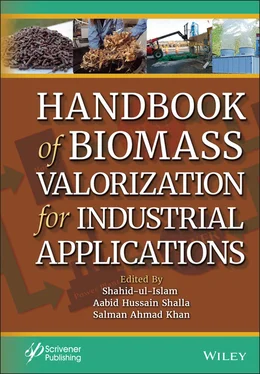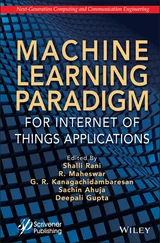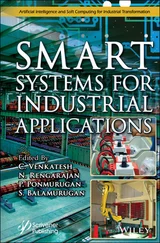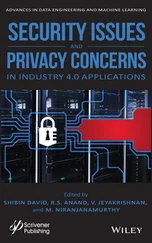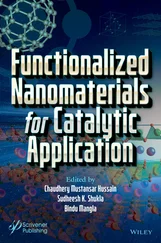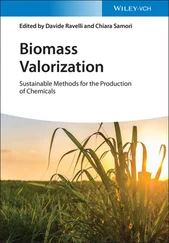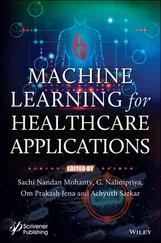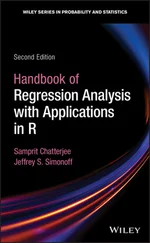1 ...7 8 9 11 12 13 ...33 Table 1.5 Important studies on photocatalytic valorization of biomass substrates [5, 14, 15].
| S. no. |
Biomass substrate with conditions |
Conversion |
Products (Y = yield, S = selectivity) |
Light radiation |
Photocatalyst |
| 1. |
Glucose |
89% |
H 2= 220 μmol (Y) |
Ultraviolet |
NiO/NaTaO 3 |
| 2. |
Glucose |
29% |
H 2= 100 μmol (Y) |
Visible |
Pt/ZnS-ZnIn 2S 4 |
| 3. |
Glucose |
83% |
H 2= 4.8 mmol (Y) |
Ultraviolet |
Pt/TiO 2 |
| 4. |
Glucose |
11% |
Glucaric acid + Gluconic acid + Arabitol = 71% (S) |
Ultraviolet |
TiO 2 |
| 5. |
HMF |
20% |
FDC = 22% (S) |
Ultraviolet |
TiO 2 |
| 6. |
Glucose |
7% |
Glucaric acid + Gluconic acid = 87% (S) |
Ultraviolet |
Cr/TiO 2/zeolite |
| 7. |
Glucose |
100% |
H 2= 5,460 μmol (Y) |
Visible |
Ru-LaFeO 3/Fe 2O 3 |
| 8. |
Glucose |
65% |
H 2= 850 μmol (Y) |
Xenon Lamp |
Rh/TiO 2 |
| 9. |
Arabinose + Glucose |
13.28% |
H 2= 60.1 μmol (Y) |
Ultraviolet |
Pt/TiO 2 |
| 10. |
Glucose |
85% |
Fructose = 55% (S) Glucaric acid = 1.5% (S) Gluconic acid = 34% (S) Erythrose = 11% (S) |
Ultraviolet |
TiO 2HPA 2/TiO 2 |
| 11. |
Cellulose |
59% |
Glucose = 48.1% (Y) HMF = 10.6% (Y) |
Visible |
Au-HYT |
| 12. |
Glucose |
11.5% |
Gluconic acid + Formic acid = 20% (S) |
Visible |
Ag-P25 |
| 13. |
Glucose |
16% |
H 2= 97 μmol (Y) |
Ultraviolet |
Pt-F-TiO 2 |
| 14. |
Glucose |
53% |
H 2= 1,700 μmol (Y) |
Ultraviolet |
Pt/TiO 2 |
| 15. |
Cellulose |
9.7% |
H 2= 600 mmol/g |
Simulated solar light |
CdS/CdO x |
| 16. |
Lignin |
85% |
Guaiacol, Vanillic acid and Vanillin and 4-Pheyl-1-1buten-4-ol = 23.2% (Y) |
Solar Light |
Pt/Bi-TiO 2(P25) |
| 17. |
Glucose |
42% |
Gluconic acid + Formic acid = 7% (S) |
Visible |
P25 |
| 18. |
HMF |
50% |
FDC = 30% (S) |
Ultraviolet |
N-TiO 2 |
| 19. |
HMF |
40% |
FDC = 50% (S) |
Natural solar |
g-C 3N 4 |
| 20. |
HMF |
31.2% |
FDC = 85.6% (S) |
Visible |
g-C 3N 4 |
| 21. |
Glucose |
69.5% |
Gluconic acid = 5.5% (Y) Formic acid = 28.2% (Y) |
Ultraviolet |
TiO 2 |
| 22. |
Glucose |
~100% |
Formate = 35% (S) |
Ultraviolet |
TiO 2 |
| 23. |
HMF |
99.1% |
FDCA = 97% (S) |
Solar |
CoPz/g-C 3N 4 |
| 24. |
HMF |
20% |
FDC + FDCA = 99% (S) |
Visible |
Nb 2O 5 |
| 25. |
Glucose |
36% |
H 2= 810 μmol (Y) |
Alogen Lamp |
Pt/TiO 2-W0.25 |
| 26. |
HMF |
27.4% |
FDC = 87.2% (S) |
Visible |
WO 3/g-C 3N 4 |
Moreover, photocatalytic reforming is also beneficial for the treatment of non-reusable/non-recyclable waste plastics (PET and PLA wastes) over various Ni based catalysts [14, 15]. Due to this photoreforming, the formation of various organic compounds (such as acetate, formate, glycolate, and glyoxal) is possible by using waste plastics. This provides a better platform of photocatalytic reforming in real world application for the eradication of specific types of plastic wastes as discussed earlier so that the contribution for non-polluting environment can be done by an inexpensive, sustainable, and solar incident light radiation process. Table 1.5provides details of conversion of various biomass substrate into valuable chemical fuels with suitable photocatalysts.
Biomass as renewable feedstock is available on this earth in ample amount as fresh raw material and waste. There are many numbers of biomass vaporization technologies such as pyrolysis, gasification, liquefaction, biochemical routes, photocatalysis, etc. Among all of them, photocatalytic valorization of biomass is recognized as an important technology to produce valuable products which can provide little redemption of pollution and also minimize the dependency on fossil fuels. Photocatalysts accelerate the rate of reaction and lower the activation energy to obtain feasibility in photocatalytic system. A large number of research studies have been carried out on photocatalysts and their enhanced activity but related reactor design aspects and knowledge about formation of side reaction is not available in sufficient manner. Therefore, researchers should focus on aforementioned issues so that photocatalytic valorization technology can be applied in proper application mode to contribute in enviro-economic sustainability system. Photocatalytic reforming combined with other technologies are also prevalent among researchers. This chapter concludes necessary information regarding background of photocatalytic valorization of biomass to produce chemical products and also point out about lack of research about other necessary issues. The step by step concluding remarks are given below to pursue research in right direction:
1 (1) Photocatalysis depends on visible light availability and lack of visible lights affects adversely the activity of photocatalysts and reduces the efficiency of this process. The alternative way of utilize of low intensity of visible light should be found as semiconductors exhibits more solar radiation which reported less in literature.
2 (2) There is less research on homogeneous photocatalysts found as compared to heterogeneous photocatalysts but TiO2 seems only heterogeneous photocatalyst in combination of other promoting catalysts. Therefore, new heterogeneous photocatalysts should be searched instead of TiO2.
3 (3) Management of biomass is not proper. We should use fresh or unused biomass rather exploitation and collect wastes generated from biomass should come into the picture. It will be more feasible.
4 (4) Separation of biomass components is big issue because cost of separation is too high; therefore, technology should be focused on use of biomass mixture as it is. Moreover, purity of biomass raw materials or waste is also a great issue to produce quality products.
5 (5) The studies on side reactions and by products are necessary rather focusing on one product. Thermodynamics and kinetics studies should be done in a proper manner so that the essence of photocatalytic valorization of biomass can achieve its optimum targets.
6 (6) Large scale production strategy is missing in literature on photocatalysis. Industries should also take consideration on utilizing this free amount of solar energy attribute.
7 (7) The information about pre-treatment of photocatalytic technology of biomass based substrates is mentioned which will be useful information of readers/researchers.
8 (8) It is recognized as nice valorization technology of biomass because it does not create pollution in the generation of electricity as compared to thermo-chemical conversion processes.
At last, the information provided in this chapter about photocatalytic valorization of biomass will be useful to pursue research in this area as it is an enviro-economic technology.
Читать дальше
